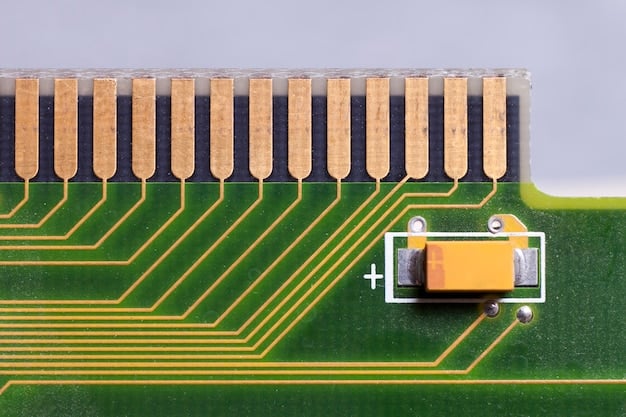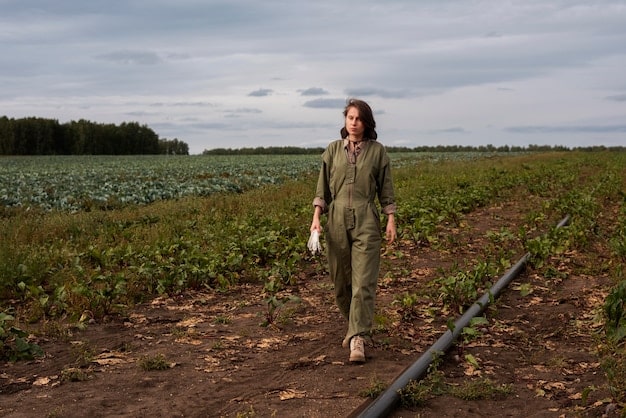US Agritech: Innovations for Sustainable Farming Driving Future

US Agritech is rapidly transforming the agricultural landscape through innovative technologies, enabling sustainable farming practices, enhancing productivity, and addressing global food security challenges with advanced solutions.
The agricultural sector is undergoing a profound transformation, driven by an imperative for sustainability and efficiency. In the United States, a vibrant ecosystem of innovation is propelling this change, ushering in what many refer to as the next green revolution. This article explores how US Agritech: Innovations for Sustainable Farming are not only enhancing productivity but also fostering environmental stewardship, ensuring a resilient future for food production.
The dawn of precision agriculture
Precision agriculture fundamentally shifts how farming is approached by integrating advanced technologies to optimize resource use and maximize yields. This methodology moves away from traditional, blanket treatments, instead focusing on precise interventions tailored to specific areas within a field. It marks a significant leap towards more efficient and environmentally friendly farming practices, reducing waste and enhancing sustainability.
This data-driven approach allows farmers to make informed decisions, minimizing the environmental footprint of their operations. By understanding the unique needs of each crop and soil type, resources such as water and fertilizers are applied only where and when needed, leading to substantial savings and reduced pollution.
GPS-guided machinery and automation
Modern farming equipment is now equipped with GPS technology, allowing for unparalleled accuracy in planting, fertilizing, and harvesting. This level of precision minimizes overlap and skips, leading to more efficient use of resources and higher yields per acre. Automation also reduces the reliance on manual labor, addressing a growing challenge in the agricultural workforce.
-
Auto-steer systems: Tractors navigate fields with sub-inch accuracy, reducing fuel consumption and operator fatigue.
-
Robotic planters: Precisely place seeds at optimal depths and spacing, ensuring uniform crop growth.
-
Automated harvesters: Efficiently gather crops, minimizing loss and maximizing output.
These systems contribute significantly to higher operational efficiency and resource conservation. The integration of GPS and automation has fundamentally altered the physical act of farming, making it less strenuous and more productive.
Variable rate technology (VRT)
VRT allows for the precise application of inputs like seeds, fertilizers, and pesticides based on real-time data from soil sensors and mapping. This ensures that each part of the field receives exactly what it needs, preventing over-application or under-application. The result is healthier crops, reduced input costs, and minimized environmental impact.
The customization offered by VRT is a game-changer for land management. It allows farmers to treat each square foot of their land as a distinct entity, optimizing its potential while safeguarding the surrounding environment. This targeted approach is a cornerstone of sustainable agriculture, demonstrating a clear path towards increased efficiency and reduced ecological strain.
Data analytics and artificial intelligence in farming
The proliferation of data in agriculture is creating new opportunities for optimizing farm management. Data analytics and artificial intelligence (AI) are transforming vast amounts of raw data—from weather patterns and soil conditions to crop health and market prices—into actionable insights. This enables farmers to move from reactive decision-making to proactive, predictive strategies, significantly improving outcomes.
Leveraging AI allows for a deeper understanding of complex agricultural systems, enabling more precise interventions. By analyzing patterns and predicting future conditions, farmers can anticipate challenges and implement preventative measures, ensuring robust harvests and economic stability.
Predictive analytics for crop health
AI algorithms analyze data from various sources, including satellite imagery, drone scans, and ground sensors, to predict potential issues like disease outbreaks, pest infestations, or nutrient deficiencies. This early detection allows farmers to intervene quickly, preventing widespread damage and reducing the need for extensive chemical treatments.
-
Yield prediction models: Accurately forecast harvest sizes based on environmental factors and crop development.
-
Pest and disease early warning systems: Alert farmers to potential threats, allowing for timely, targeted interventions.
-
Nutrient deficiency mapping: Identifies areas needing specific nutrient applications, optimizing fertilizer use.
These predictive capabilities are critical for minimizing crop loss and maximizing resource efficiency. The ability to foresee problems before they escalate is a monumental advantage, safeguarding both economic returns and ecological health.
Farm management software and decision support systems
Integrated software platforms provide farmers with a holistic view of their operations, consolidating data from various sources into a single, intuitive dashboard. These systems offer decision support tools, helping farmers optimize planting schedules, irrigation, fertilization, and harvesting based on real-time and historical data. This integration streamlines complex processes, making farm management more efficient and less prone to human error.
The centralization of information through these platforms empowers farmers with comprehensive insights, facilitating strategic planning and operational adjustments. Such systems are instrumental in transitioning agriculture towards a more intelligent, responsive, and ultimately, sustainable model. They represent a significant step forward in transforming raw agricultural data into valuable, actionable intelligence.
Sustainable water management technologies
Water scarcity is a critical challenge facing agriculture globally. In the US, agritech innovations are providing solutions for more sustainable water use, ensuring that every drop counts. These technologies range from advanced irrigation systems to sophisticated water monitoring tools, all designed to optimize water application and reduce waste. The focus is on doing more with less, which is vital for long-term agricultural viability.
Implementing these advanced water management strategies is crucial for long-term ecological balance and agricultural resilience. By mitigating water waste, these technologies not only preserve a vital natural resource but also contribute to the economic efficiency of farming operations, demonstrating a commitment to responsible environmental stewardship.

Drip irrigation and smart sprinklers
Traditional irrigation methods can be inefficient, leading to significant water loss through evaporation and runoff. Drip irrigation delivers water directly to the plant roots, minimizing waste. Smart sprinkler systems use weather data and soil moisture sensors to adjust watering schedules automatically, ensuring plants receive optimal hydration without over-watering.
-
Water conservation: Drip systems reduce water use by up to 60% compared to traditional methods.
-
Disease prevention: Direct root application reduces leaf moisture, minimizing fungal disease risks.
-
Nutrient efficiency: Fertilizers can be applied directly through the drip lines, maximizing absorption.
These systems are pivotal in minimizing water consumption, especially in arid regions. By focusing water delivery more precisely, they contribute to substantial water savings and enhanced crop health, making farming more resilient against climatic challenges.
Soil moisture sensors and weather stations
A network of sensors provides real-time data on soil moisture levels, informing irrigation decisions. Integrated with local weather stations, these systems can predict future water needs, allowing farmers to prepare for dry spells or excessive rainfall. This proactive approach prevents both waterlogging and drought stress, optimizing growing conditions.
The data from these sensors provide invaluable insights into localized microclimates and soil conditions, enabling more adaptive and responsive irrigation strategies. This constant feedback loop helps farmers fine-tune their water usage, moving closer to a state of equilibrium with environmental conditions. Such precision is key to ensuring sustainable water resources for future generations in agriculture.
Biotechnology and genetic engineering
Biotechnology and genetic engineering offer powerful tools for developing crops that are more resilient, nutritious, and sustainable. By modifying the genetic makeup of plants, scientists can enhance traits such as pest resistance, drought tolerance, and nutrient uptake, reducing the need for chemical inputs and optimizing yield. These advancements represent a frontier in agricultural innovation, promising significant improvements in food production efficiency and environmental impact.
These biotechnological advancements aren’t just about higher yields; they’re about creating a more robust and adaptable food system capable of thriving in diverse conditions. The innovations offer a pathway to reduce the environmental footprint of farming, contributing to a more sustainable agricultural landscape while addressing global food security needs.
Genetically modified (GM) crops for resistance
GM crops are engineered to resist specific pests, diseases, or herbicides, significantly reducing the need for chemical sprays. For example, some corn varieties are engineered to produce a natural pesticide, protecting them from insects without external application. This targeted approach has profound benefits for environmental health and farm profitability.
-
Reduced pesticide use: Directly lowers chemical runoff and exposure.
-
Increased yields: Protected crops suffer less damage, leading to higher productivity.
-
Enhanced farm safety: Less handling of hazardous chemicals for farmers.
These innovations offer a path toward more resilient agriculture, directly addressing the challenges of pest management and environmental stewardship. By providing inherent resistance, GM crops contribute to a more sustainable and less chemically dependent farming model, benefiting both producers and consumers.
CRISPR and gene editing for enhanced traits
CRISPR-Cas9 technology allows for precise editing of plant genes, accelerating the development of crops with enhanced nutritional value, improved shelf life, or greater tolerance to extreme weather conditions. Unlike traditional GM methods, CRISPR can make subtle, targeted changes, often mimicking natural mutations. This precision opens doors to new possibilities for sustainable crop development without introducing foreign DNA.
The ability to fine-tune plant characteristics through gene editing is revolutionizing crop development, offering solutions for real-world agricultural challenges. This precision technology significantly shortens breeding cycles and enables the creation of tailor-made crops that thrive in specific environments, contributing to global food security with minimal environmental disruption.
Vertical farming and controlled environment agriculture (CEA)
As urban populations grow and arable land becomes scarcer, vertical farming and Controlled Environment Agriculture (CEA) offer revolutionary solutions. These methods involve growing crops in stacked layers, often indoors, with carefully controlled environmental parameters. This approach maximizes space efficiency, minimizes water usage, and allows for year-round production, regardless of external climate conditions.
CEA’s independence from weather and soil quality makes it an invaluable innovation for ensuring food security in diverse geographical areas. By concentrating production in smaller footprints, these methods free up valuable agricultural land for other uses and significantly reduce the carbon footprint associated with transport.
Hydroponics and aeroponics systems
Hydroponics involves growing plants in nutrient-rich water solutions without soil, while aeroponics grows plants by misting their roots with nutrients. Both methods use significantly less water than traditional farming and allow for precise control over nutrient delivery. They are ideal for vertical farms, maximizing plant density in a confined space. These systems are key to achieving high yields in urban settings.
-
Water efficiency: Recirculation systems reduce water use by up to 90%.
-
Faster growth rates: Optimized nutrient delivery promotes accelerated plant development.
-
Space utilization: Vertical stacking allows for high-density cultivation in limited areas.
These advanced growing techniques are not only highly efficient but also capable of producing fresh produce closer to consumers, reducing transportation costs and increasing the freshness of food. This shift is particularly beneficial for urban food deserts and areas with limited arable land, ensuring greater access to healthy food.
LED lighting and climate control
Indoor farming relies on LED lights tailored to provide the specific light spectrum optimal for plant growth, mimicking sunlight. Sophisticated climate control systems regulate temperature, humidity, and CO2 levels, creating the perfect growing conditions. This level of environmental manipulation eliminates many risks associated with outdoor farming, such as pests, unpredictable weather, and seasonal limitations.
The meticulous control over every environmental variable in CEA systems ensures consistent, high-quality yields year-round. This precision farming model not only optimizes growth but also significantly minimizes the reliance on traditional agricultural inputs, moving towards a truly sustainable food production paradigm. The stability and predictability offered by these systems are game-changers for food supply chains.
Challenges and the path forward
While the promise of agritech is immense, its widespread adoption faces several challenges. These include the high initial investment costs for new technologies, the need for skilled labor to operate complex systems, and the digital divide that may leave smaller farms behind. Ensuring equitable access to these innovations is crucial for a truly sustainable agricultural future. Addressing these barriers requires a concerted effort from policymakers, technology developers, and financial institutions.
Overcoming these hurdles demands innovative financing models, accessible training programs, and infrastructure development to support new technologies. Collaboration among stakeholders is essential to ensure that the benefits of agricultural innovation are widely distributed, fostering a more resilient and equitable food system for all.
Bridging the digital divide in rural areas
Many rural areas lack the robust internet infrastructure necessary to support data-intensive agritech solutions. This digital divide prevents smaller farms from accessing and benefiting from these advancements. Initiatives aimed at expanding broadband access and providing affordable technology solutions are essential to ensure that all farmers can participate in the agritech revolution.
This gap in connectivity not only impacts productivity but also impedes access to critical information and market opportunities. Bridging this digital divide is a fundamental step towards leveling the playing field for all farmers, regardless of their location, fostering inclusive growth in the agricultural sector and ensuring economic viability for rural communities.
Investment and policy support
Government policies and private investments play a crucial role in fostering agritech innovation and adoption. Tax incentives, subsidies for sustainable practices, and funding for research and development can accelerate the transition to advanced farming methods. Public-private partnerships are also vital for scaling up successful technologies and making them accessible to a broader range of farmers.
Strategic investment and supportive policies are the bedrock upon which the future of sustainable agriculture will be built. By creating a nurturing environment for innovation,
governments can catalyze the widespread adoption of technologies that not only increase food production but also safeguard natural resources, ensuring a resilient agricultural future for all.
| Key Innovation | Brief Description |
|---|---|
| 🌱 Precision Ag | GPS-guided machinery and VRT for optimized resource use. |
| 🤖 AI & Data Analytics | Predictive models and FMS for proactive farm management. |
| 💧 Sustainable Water | Drip irrigation, smart sprinklers, and soil sensors for water efficiency. |
| 🧬 Biotechnology | GM crops and gene editing for enhanced resilience and traits. |
Frequently asked questions
▼
Agritech refers to the application of technology to improve the efficiency, productivity, and sustainability of agriculture. It encompasses various innovations like precision farming, biotechnology, automation, and data analytics, all aimed at optimizing food production and resource management in the farming sector.
▼
Agritech fosters sustainable farming by enabling more precise use of resources like water and fertilizers, reducing waste and environmental impact. Technologies such as drip irrigation and AI-driven predictive analytics help minimize chemical runoff, conserve water, and enhance soil health, supporting long-term ecological balance.
▼
Precision agriculture offers numerous benefits, including optimized resource allocation, reduced environmental impact from excessive input use, increased crop yields, and improved profitability for farmers. Its data-driven approach leads to more informed decision-making and efficient farm management, benefiting both the economy and ecology.
▼
Yes, vertical farming holds significant promise for enhancing food security, particularly in urban areas or regions with limited arable land. By growing crops in vertically stacked layers under controlled conditions, it allows for year-round production, reduces water usage, and minimizes transportation needs, ensuring a more consistent and local food supply.
▼
Challenges to Agritech adoption include high initial investment costs for advanced technologies, the need for specialized skills to operate complex systems, and the digital divide limiting access in rural areas. Addressing these requires strategic policy support, investment, and educational initiatives to ensure widespread, equitable implementation across the agricultural sector.
Conclusion
The landscape of agriculture is undeniably being reshaped by the remarkable advancements in US Agritech. From the nuanced precision of autonomous machinery to the profound insights offered by AI, and the resourcefulness of vertical farming, these innovations are not merely incremental improvements but foundational shifts. They promise a future where farming is not only more productive and profitable but also deeply intertwined with environmental sustainability. While significant challenges remain, a concerted effort from all stakeholders can ensure that the promise of agritech translates into widespread benefits, securing a resilient and sustainable food system for generations to come. The trajectory is clear: technology and agriculture are converging to cultivate a more abundant and sustainable future.





